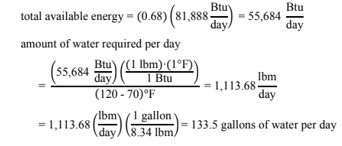Assume that the solar collector system of Problem 7.2 has an average efficiency of 60% during the month of January and 68% during the month of June. On average, how many gallons of supply water at 70°F could be heated to 120°F by the system each day during each month?
What will be an ideal response?
For January, total solar energy intercepted by the collectors each day

Considering the efficiency of the system is 60% in January,

amount of water required per day

For June, total solar energy intercepted by the collectors each day

Considering the efficiency of the system is 68% in June,

You might also like to view...
The direct input of solar energy produces which of the following forms of renewable (indirect) solar energy?
a. Wind b. falling and flowing water c. Biomass d. wind, falling and flowing water, and biomass e. only wind and falling and flowing water
The process of isostasy is responsible for
A) moving plates apart at a divergent margin B) creating volcanoes at a hot spot C) causing rock uplift in mountain ranges in response to erosion D) causing compressive stresses at convergent boundaries
More than half of all hurricanes:
A) produce at least one tornado. B) make landfall in the United States. C) reach Category 5 strength. D) have storm surges that are at least 25 feet deep.
As defined by the International Astronomical Union in 2006, a(n) ____ is a celestial body in orbit around the Sun, with sufficient gravitational attraction to overcome rigid body forces, has a nearly spherical shape, and has cleared the neighborhood around its orbit
a. satellite b. comet c. asteroid d. planet e. meteor